The Microsoft Surface Studio Review
by Brett Howse on January 20, 2017 8:00 AM EST- Posted in
- Desktop
- Microsoft
- Surface
- Surface Studio
The PixelSense Display
Microsoft has been pushing display technology since the original Surface RT launched, but it is only recently that they have gotten really serious about quality displays. The Surface Pro 4 and Surface Book both feature the best displays in their class, with very accurate color reproduction and high pixel densities. The move to the 3:2 aspect ratio with the Surface Pro 3 was a game changer for that tablet, and it is great to see they have stuck with this even with the much larger Surface Studio.
There is a lot to talk about in regards to the display of the Surface Studio. First of all, it is truly a “wow” moment for practically anyone who sees it. We can get a bit carried away with talk of pixels, color gamuts, and contrast, but pretty much anyone who has seen this Surface Studio has said “wow” whether they are technical or not. The combination of a huge number of pixels, a very large display, good brightness, and the not so average aspect ratio really make the Studio stand out. The fact that it’s all in a 12.5 mm thick design is the icing on the cake.
A few pages ago, I spoke of attention to detail. There is nowhere this is more apparent than the Surface Studio’s 28.125-inch PixelSense display. It’s not a 28-inch display. It’s not a 28.5-inch display. It is a 28.125-inch display, and this size was decided upon to make sure this display can be scaled almost perfectly within Windows. It was something that would have been chosen way back at the very beginnings of the project.
Combined with the 4500x3000 resolution, the 28.125-inch display works out to almost exactly 192 pixels per inch. That may not seem like a very large number, or a very significant number, when you have smartphones with almost 600 pixels per inch, but 192 is exactly double 96. Why does 96 matter? 96 DPI is what Windows was originally built around, so if you had a display with 96 DPI, one inch on the display would be exactly one inch on a printed paper. With the Surface Studio, they have doubled the DPI so that Windows can be run at exactly 200% scaling, but keep the correct dimensions for everything on the display. When the Surface Studio was announced, the head of Surface, Panos Panay, held up a 8.5x11-inch piece of paper to the Surface Studio and showed that it was exactly the same size as the original word document on the display. None of this was an accident. Attention to detail, again.
Let’s not just glance over the resolution either. 4500x3000 is a huge number of pixels; 13.5 million to be precise. This is almost 63% more pixels than a 4K display, and just 8% under a 5K display. It’s one of the reasons you won’t see me use the term "4K" or "5K" or "8K" for displays, since it really does the display an injustice. Some people have called the Surface Studio a 4.5K display, hinting that it’s between a 4K and a 5K, but it is way closer to 5120x2880 than it is to 3840x2160, with the former having about 14.75 million pixels, and the latter only 8.3 million (and a Full HD 1920x1080 is just a hair over 2 million pixels). The Surface Studio’s display is very sharp for a desktop, and the perfect 200% scaling makes it a treat to work with. Add in the aspect ratio giving you over 50 square inches more display than a 27-inch 16:9 display, and it can start to become apparent why this display is such a stunner.
Another feature of the display that Microsoft touted at the launch event is that the Surface Studio is a wide-gamut display, with the Studio featuring DCI-P3 color space support. There is a toggle in the Action Center that lets you choose among sRGB, DCI-P3, and Vivid color modes. Each of these color targets are actually an ICC profile, and each display is individually calibrated to ensure that they correctly display each color gamut.
sRGB should be well known to our readers, but this is the most common color gamut in computing, with almost all images and web content targeting sRGB. Meanwhile DCI-P3 is a bit more complex. DCI-P3 started life as the color gamut used in cinema, with a wider color spectrum and much more green white point. In fact, cinema DCI-P3 is so green that it is almost impossible to use on the Studio. DCI-P3 was designed for low light in a movie theatre, and in addition to having a different white point, it also has a gamma of 2.4, making it not all that useful when using the Studio as a typical desktop.
But there is also this third color profile, which Microsoft called “Vivid” and you’re likely thinking, what the heck is that? Vivid is in fact the correct P3 color gamut for use on a desktop, and it’s called P3 D65, where D65 is the white point, and it has a 2.2 gamma (both of which are carried over from sRGB). P3 D65 is the same P3 color space you would find on an iPhone, iMac, or iPad Pro, and it offers the same wider color gamut, but with a white point that is white, and not green.
Microsoft did a fantastic job of adding three color gamuts to the Surface Studio, and they even made it simple to choose which one you need, but by naming two of them by their proper name, and the third by an adjective, makes it very confusing. DCI-P3 and P3 D65 are not great names, nor is sRGB, but at least a quick search on the internet would let even an inexperienced person know what they have. They really need to fix the name on Vivid, because if you had content in the P3 color space, more than likely it would target P3 D65. But unless you were aware that Vivid was correct, you may choose the DCI-P3 space which would make it look awful. Offering the cinema DCI-P3 standard is not a bad thing, mind you, but Microsoft should be directing users to P3 D65 instead, as that's the de facto standard for computers.
The added gamuts are welcome though, as is the Action Center toggle to choose the one you need, but because Windows doesn’t have proper color management, the end user needs to make the decision on which gamut to target. Microsoft needs to fix this, and fix it soon, since it is a problem that is only going to get larger as time goes on. You can run the display in Vivid all the time, but program designed for the sRGB color space will end up having the colors oversaturated. So although there are three color spaces, most people should use sRGB almost exclusively, which is a bit of a shame.
But enough preamble. How good is the Surface Studio’s display? Let’s find out.
Brightness, Contrast, Uniformity, and the Color Modes
As with any display, we test using SpectraCal’s CalMAN suite, and leverage the X-Rite i1Display Pro colorimeter for brightness and contrast readings, and the X-Rite i1Pro2 Spectrophotometer for color accuracy. For 2017, laptop displays, as well as the Surface Studio, will be subjected to a more thorough display test than in the past, with more points tested in both grayscale and saturation.
Using the colorimeter to test the display brightness and contrast gives a more accurate reading than using a spectrophotometer for this, because a spectrophotometer does not read black levels as well due to extra noise on the sensor. We test contrast at maximum brightness, and then set the display to 200 nits for the remainder of the tests.
Brightness and Contrast
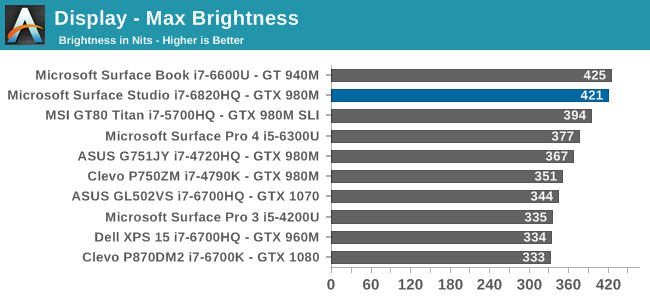
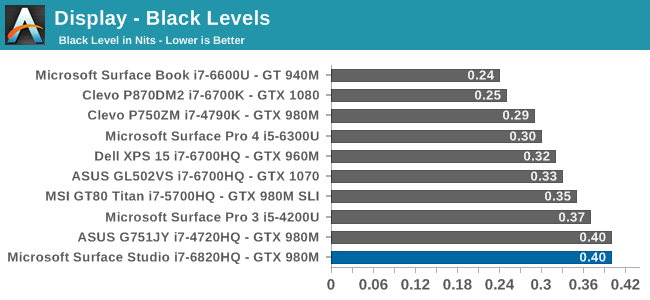
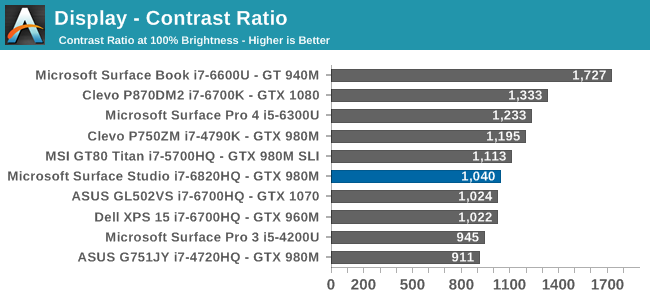
The Surface Studio can get very bright, especially for a desktop. 421 nits is one of the highest brightness levels we’ve seen in a desktop monitor. Even in the most well-lit office setting, this level of brightness should be plenty for almost anyone. The contrast ratio being just over 1000:1 is also a decent result, although nowhere near the over 1700:1 of the Surface Book. The excellent contrast ratio is one of the best features of the Book, so only getting 1000:1 on the Studio was a bit disappointing, but nonetheless it is one of the higher contrast ratios of any desktop display we have tested.
For those that like to work in a dark office, the Surface Studio’s display will go all the way down to just 3 nits, which is also an excellent result. There is plenty of brightness range for anyone to find a comfortable level.
Uniformity
On smaller displays, such as tablets and notebooks, we don’t generally test uniformity, but it is a good thing to test on a desktop display, where the sheer size of the display can cause some real issues for a poorly designed backlight. Since the Surface Studio is edge lit, there is always going to be some issues with uniformity due to the nature of that type of backlight, as compared to a full-array backlight on a monitor.
There is definitely some drop in the white output in the upper corners of the display, as well as along the top edge. The black levels also drop here, although since it was tested with a spectrophotometer the black levels won’t be absolutely accurate. On a percentage basis, there is about 20% less light in the top right corner, and just a bit under that on the top right corner. However the rest of the display is quite a bit more uniform.
Next, the color levels were tested across the display, and here the result is quite a bit better than the brightness levels. The backlight issues in the top corners still causes some shift in color right at the edges, but overall the dE2000 across the rest of the display is fantastic for an edge-lit display.


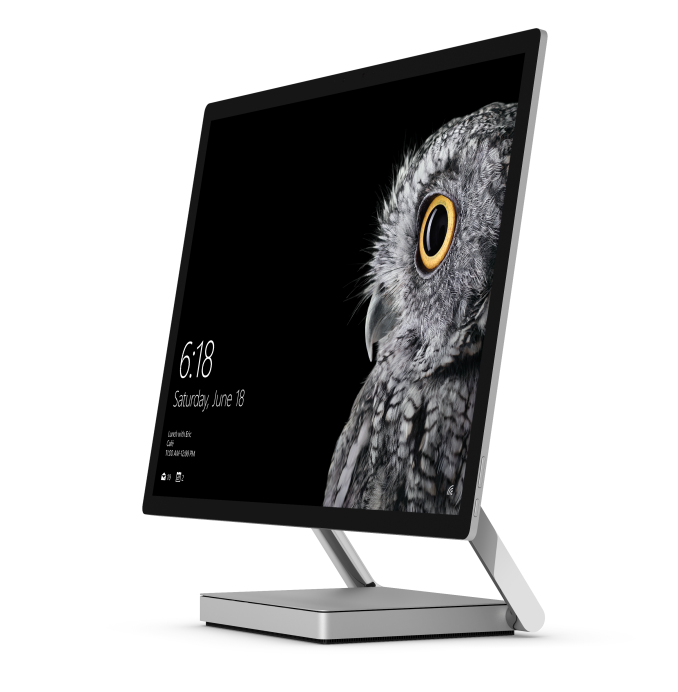
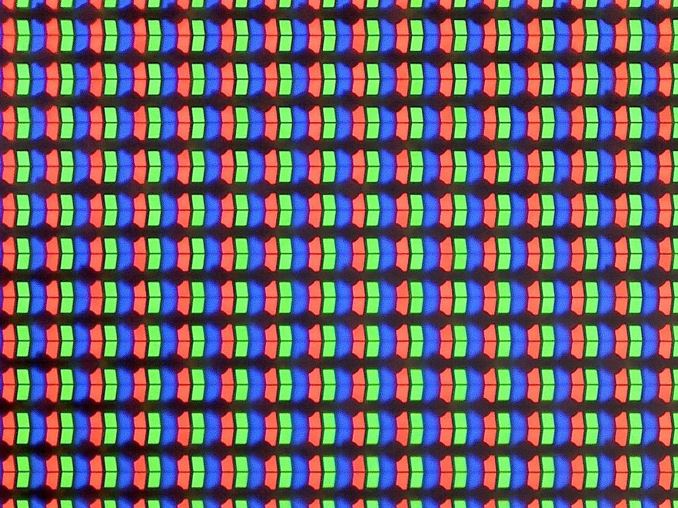
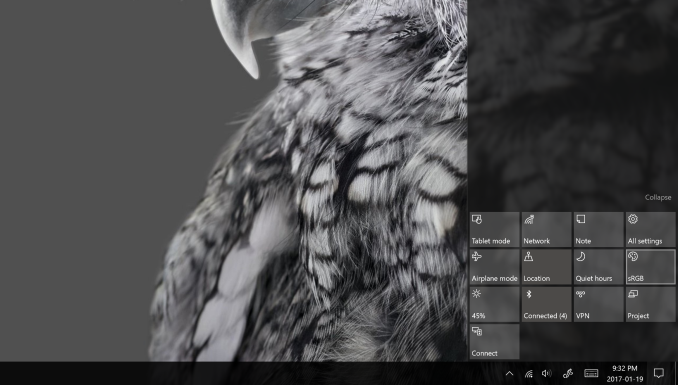
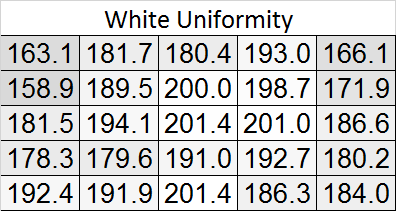
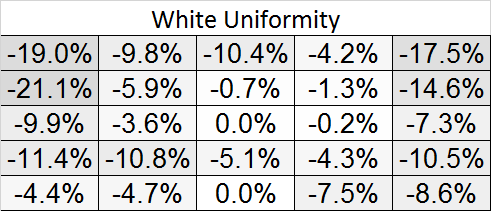
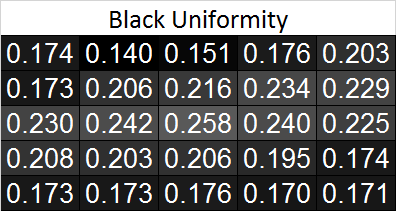









197 Comments
View All Comments
Manch - Monday, January 23, 2017 - link
I saw where you mentioned that the stress has to be supported at one end or another but its been proven that it can handle the stress just fine. As for the gap, while aesthetically unpleasing to some, or pleasing to others, I just don't see the big deal. Like others said, it ensures the keys don't contact the screen and unlike some laptops ahem Mac Book, key travel hasn't been sacrificed.BrokenCrayons - Tuesday, January 24, 2017 - link
I'd argue that it's been readily proven that the hinge design has been proven to fail under stress over time and there's little to no information available regarding the ability of the Surface Book to cope well with weight as a consequence to its design. However, there's a healthy dose of common sense that would make it pretty clear that half the plastic and metal would be less effective at supporting pressure from above or below than all of the plastic and metal.Key travel though, that's a point I agree with. Microsoft did manage to get that done in a manner of speaking, but it really didn't have to be that way to begin with if they'd bothered to add a largely unnoticable couple of millimeters of thickness. Instead, just like Apple and other companies, the Surface Book is chasing a pretty meaningless thickness measurement and surrendering functionality to do so. In the case of the Surface Book, that compromise is even more silly because the advantage of reduced thickness is ultimately still lost because there's a gap that ultimately makes the system thicker than it would have been had Microsoft recessed the keys and still maintained key travel distance.
jlabelle2 - Thursday, January 26, 2017 - link
- the hinge design has been proven to fail under stress over timeSo I am sure you have sources for that, do you?
- Instead, just like Apple and other companies, the Surface Book is chasing a pretty meaningless thickness measurement
They indeed made exactly the contrary. Instead of doing like Apple an put an almost no travel keyboard and standard hinge for specs bragging, they design a UNIQUE hinge that allow the screen to be further away when deployed for a better balancing and they put one of the maximum travel keyboard for comparably sized keyboard.
The hinge is not showing millimeters as you critizise but adds some at the gain of functionality.
nabnel - Friday, January 20, 2017 - link
Too many people comment and criticize the hinge design without actually understanding its function or why it's there. The hinge is designed to extend the effective base size when the laptop is opened, so that the weight distribution leaves it balanced and not top-heavy when used as a laptop. This is needed because the screen is heavier by a bit much than a typical laptop's screen. The other option wouldve to put more weight into the base, but that would increase the overall weight if the system.vLsL2VnDmWjoTByaVLxb - Friday, January 20, 2017 - link
The hinge design is criticized because it eventually results in a loose connection between the base and screen, the most important vital connection for a laptop. This results in keyboard drops, display resets, total machine crashes, and the inability to, you know, work on your $2000+ device. Having a Tablet isn't worth this instability.It's a design flaw. Every daily-used Surface Book will eventually see the hinge weaken and the above effects happen over and over again.
jlabelle2 - Monday, January 23, 2017 - link
- This results in keyboard drops, display resets, total machine crashesAny sources of that?
I have a Surface Pro 3 and having a removal keyboard never caused me the kind of issues you are claiming.
And having a separate tablet built-in in your laptop CERTAINLY worth it, I assure you.
- It's a design flaw.
The removal screen portion is a "design flaw"? You are kidding right?
BrokenCrayons - Monday, January 23, 2017 - link
"The removal screen portion is a "design flaw"? You are kidding right?"You're missing the context clues, I think intentionally, in order to suggest the idea of a removable screen/tablet is flawed in order to build a credible argument through suggesting that someone else is stating something stupid when that's not at all the case. Dockable tablets arent the problem. The hinge and connection, as already mentioned multiple times in this article's comments, is poorly engineered.
jlabelle2 - Thursday, January 26, 2017 - link
- The hinge and connection, as already mentioned multiple times in this article's comments, is poorly engineered.Which I think is an even more stupid comment. Look again the video of the hinge and compare to anything else on the market and you will realize that it is still unique and unrivalled design.
And anyone that own a Surface Book are praising the hinge, not the contrary.
BrokenCrayons - Thursday, January 26, 2017 - link
Unique doesn't automatically mean "better." I realize you want to defend this for psychological rather than practical reasons and that's completely okay. A handful of people can't help but fall in love with computers and honestly need to in order to justify why something is or isn't better than something else. Men in particular love comparing things and measuring differences in order to reach a conclusion that supports their underlying desires and will go as far as selecting other things that support their mental state. Say, comparing a Surface Book to a bottle of hand sanitizer and saying the Surface Book has better battery life and more storage space. I understand that it often can't be helped, but I encourage you to put human psychology under a critical microscope and attempt to transcend your biology during the process of thinking critically.Manch - Friday, January 27, 2017 - link
Please provide links for this massive hinge failure bc I cant find it.